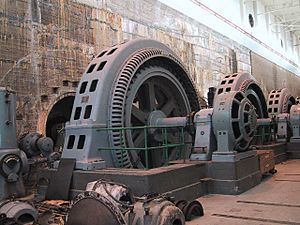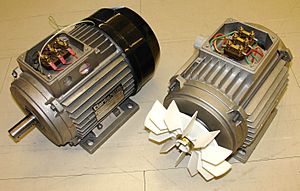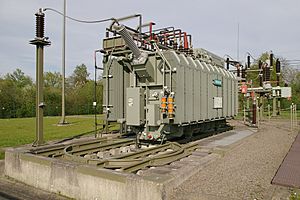Electric machine facts for kids
An electric machine is a cool device that uses electromagnetism to make things happen. Think of them as energy changers! They can turn electricity into movement, or movement into electricity.
The most common electric machines are electric motors and electric generators. Motors make things move, like in your fan or a washing machine. Generators create electricity, like the huge ones in power plants that light up our cities.
Another important type of electric machine is the transformer. Even though it doesn't have moving parts, it changes the voltage of alternating current (AC) electricity, making it higher or lower.
Electric machines are super important! Generators produce almost all the electricity we use on Earth. And electric motors use about 60% of all that electricity. They've been around since the mid-1800s and are everywhere in our daily lives. Making them more efficient helps save energy and is good for the planet!
Contents
Generator
An electric generator is a machine that turns mechanical energy (movement) into electrical energy. It makes electrons flow through wires, creating electricity. It's a bit like a water pump that makes water flow, but doesn't create the water itself.
The mechanical energy to run a generator can come from many sources. It could be steam engines, water falling through a turbine, an internal combustion engine (like in a car), a wind turbine, or even a hand crank!
Electric machines have two main parts:
- The rotor is the part that spins.
- The stator is the part that stays still.
In terms of how they work with electricity:
- The armature is where the electricity is actually produced.
- The field creates the magnetic force needed for the machine to work.
The armature can be on either the rotor or the stator. The magnetic field can be made by electromagnets or permanent magnets. Generators are usually divided into two types: AC generators and DC generators.
AC generator
An AC generator changes mechanical energy into alternating current (AC) electricity. AC is the type of electricity that flows in your home. In most AC generators, the magnetic field part (field winding) is on the rotor, and the power-producing part (armature winding) is on the stator.
There are different kinds of AC generators:
- An induction generator uses the stator's magnetic field to create currents in the rotor. When the rotor spins faster than a certain speed, it sends power back to the electrical grid.
- A synchronous generator (also called an alternator) gets its magnetic field from a separate DC current source. This source can be built into the machine.
DC generator
A DC generator is a machine that turns mechanical energy into Direct Current (DC) electrical energy. DC electricity flows in only one direction, like from a battery. A DC generator usually has a special part called a commutator with split rings. This part helps to make the electricity flow in one direction, creating direct current instead of alternating current.
Motor
An electric motor does the opposite of a generator: it changes electrical energy into mechanical energy (movement). Most electric motors work by using interacting magnetic fields and wires that carry electric current. These interactions create a spinning force.
Motors and generators are very similar. In fact, many types of electric motors can also work as generators, and vice versa!
Electric motors are used in tons of things around us. You'll find them in industrial fans, pumps, machine tools, household appliances (like blenders), power tools, and even computer disk drives. They can run on either direct current (DC) or alternating current (AC), which leads to their two main types: AC motors and DC motors.
AC motor
An AC motor changes alternating current electricity into mechanical energy. It usually has two main parts:
- A stationary (still) outside part called the stator. It has coils that get AC electricity, which creates a spinning magnetic field.
- A spinning inside part called the rotor. This part is attached to the output shaft and is pushed by the spinning magnetic field, making it turn.
The two main types of AC motors are known by the kind of rotor they use:
- In an induction motor, the rotor's magnetic field is created by an induced current (electricity created by a changing magnetic field). The rotor has to spin a little slower (or faster) than the stator's magnetic field to create this induced current.
- A synchronous motor doesn't rely on induction. It can spin at exactly the same speed as the electricity supply's frequency, or a simple fraction of it. The rotor's magnetic field is made either by direct current fed through special rings or by a permanent magnet.
DC motor
A brushed DC electric motor creates movement directly from DC power. It uses internal parts called brushes and a commutator to send electricity to the spinning wires (windings) on the rotor.
Brushless DC motors are a bit different. They have a spinning permanent magnet in the rotor and stationary electrical magnets on the motor housing. A special controller changes the DC power into AC power for the motor. This design is simpler because it doesn't need brushes to transfer power to the spinning rotor.
An example of a brushless DC motor is a stepper motor. These motors can divide a full rotation into many small, precise steps, which is useful for things like 3D printers.
Transformer
A transformer is a device that doesn't move. It changes alternating current (AC) electricity from one voltage level to another. It can make the voltage higher (step-up), lower (step-down), or keep it the same. It does all this without changing the frequency of the electricity.
A transformer moves electrical energy from one circuit to another using coils of wire that are linked by magnetism. When a changing electric current flows through the first coil (called the primary winding), it creates a changing magnetic flux in the transformer's core. This changing magnetic field then creates a changing voltage in the second coil (the secondary winding). This effect is called mutual induction.
There are three main types of transformers based on what they do:
- Step-up transformer (increases voltage)
- Step-down transformer (decreases voltage)
- Isolation transformer (keeps voltage the same but separates circuits)
Based on their structure, there are four common types:
- Core type
- Shell type
- Power type
- Instrument type
Polyphase AC machines
Most large electric machines use something called "polyphase" AC power. The most common is 3 phase power. This means the machine has multiple sets of windings (coils) that are powered by AC currents that are slightly out of sync with each other. For 3-phase machines, these currents are 120 degrees apart.
3-phase machines have some big advantages over single-phase ones:
- The power they produce or use is more constant and smooth.
- They can be smaller and cost less for the same amount of power.
- Sending 3-phase power over three wires needs less metal than sending the same power over two wires for single-phase.
- They have a better power factor, which means they use electricity more efficiently.
Electrostatic machines
In electrostatic machines, the movement is created by electric charges attracting or pushing each other in the rotor and stator.
Electrostatic generators create electricity by building up electric charge. Early ones used friction, while later ones used electrostatic induction. The Van de Graaff generator is a type of electrostatic generator still used in science research today.
Homopolar machines
Homopolar machines are a unique type of DC machine. They work by supplying current to a spinning wheel through brushes. The wheel is placed in a magnetic field, and the movement is created as the current travels through the wheel and the magnetic field.
Electric machine systems
Today, electric machines often work with electronic controls. These controls help the machines run in the best way possible, making them more efficient and easier to manage.
See also
 In Spanish: Máquina eléctrica para niños
In Spanish: Máquina eléctrica para niños




